The EHS industry is currently in the middle of a quickly changing time. Driven by technological advances and a focus on sustainability, EHS is rapidly shedding its traditional image of rulebooks and checklists, not to mention binders and spreadsheets.
According to recent data gathered by Verdantix, the EHS software market is projected to reach $2 billion globally in 2024, with North America poised to capture a significant 50% share.
This dominance reflects a growing recognition of the value proposition that EHS technology offers: Empowering businesses to move beyond mere compliance and proactively manage safety, health, and environmental risks. Saving lives, cutting cost and making the workplace a better place to be.
But Verdantix’s insights paint a broader picture, looking beyond just market size. This article looks into the exciting future of EHS, exploring how cutting-edge technologies, a culture of employee engagement, and a commitment to environmental responsibility will converge to create a safer, healthier, and more sustainable work environment for everyone.

Major Growth Projected for 2024 and Beyond
The growth that the EHS industry is currently in is being fueled by a surge in innovative solutions. As Chris Sayers, Verdantix Senior Analyst, predicts, “In the thriving EHS software landscape, North America is poised to command 50% of the $2 billion global market in 2024.” This dominance reflects a strong focus on compliance and a growing recognition of the value proposition that EHS software offers. But the story doesn’t end there.
Here’s what we can expect beyond 2024:
- Expansion into the Mid-Market: Traditionally the domain of large enterprises, EHS software is becoming increasingly accessible to mid-sized companies. This trend is likely to accelerate, driven by the development of more affordable and user-friendly platforms.
- Tapping into Low-Risk Industries: Industries historically considered “low-risk” are recognizing the benefits of proactive EHS management. Technologies like AI-powered risk assessment and automated data collection will make it easier for these sectors to implement robust safety programs.
- Navigating a Dynamic Regulatory Landscape: As environmental and safety regulations become more complex and evolve rapidly, EHS software will play a crucial role in ensuring compliance. Software with real-time updates and integrated regulatory modules will empower businesses to stay ahead of the curve.
Beyond these specific predictions, several emerging technologies promise to further transform the EHS landscape:
- Artificial Intelligence (AI): AI-powered tools will become commonplace, automating tasks, predicting hazards, and providing real-time insights to improve decision-making.
- Internet of Things (IoT): Sensor networks will collect real-time data on environmental conditions, worker safety, and equipment health, enabling proactive risk management and preventive maintenance.
- Big Data Analytics: Advanced analytics will allow EHS professionals to identify trends, predict potential problems, and develop data-driven safety strategies. The future of EHS technology is brimming with possibilities. As these innovations continue to mature, we can expect a significant shift towards a more predictive, preventive, and data-driven approach to safety, health, and environmental protection.
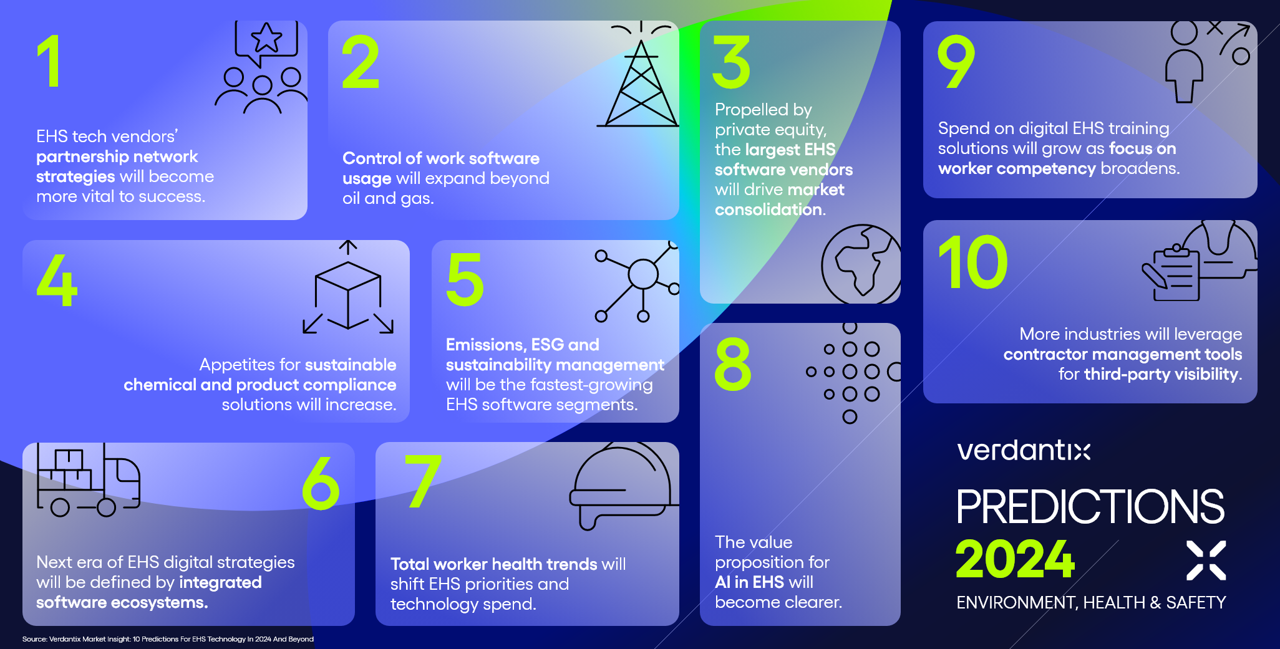
A High-Tech Horizon with Engaged Employees
The future of EHS is not a singular path, but rather an intersection of two powerful forces:
• Cutting-edge technology
• Highly engaged workforce
That’s because technology, while powerful, is only one piece of the puzzle. A truly effective EHS program hinges on the active participation of an engaged workforce. As Rain Chiang, Analyst at Verdantix, emphasizes, “Safety needs to be seen as an integral part of the broader organizational culture, not just a compliance burden.”
Here’s how EHS can foster a culture of engagement:
- Empowering Employees: Mobile apps and user-friendly interfaces will empower employees to take ownership of their safety. They can easily report hazards, access safety data, and participate in safety training programs.
- Gamification for Good: Gamification elements can make safety training interactive and engaging, promoting knowledge retention and encouraging participation.
- Open Communication Channels: Transparent communication is key. Regular safety briefings, two-way feedback mechanisms, and recognition programs will foster a sense of trust and encourage employees to raise safety concerns openly.
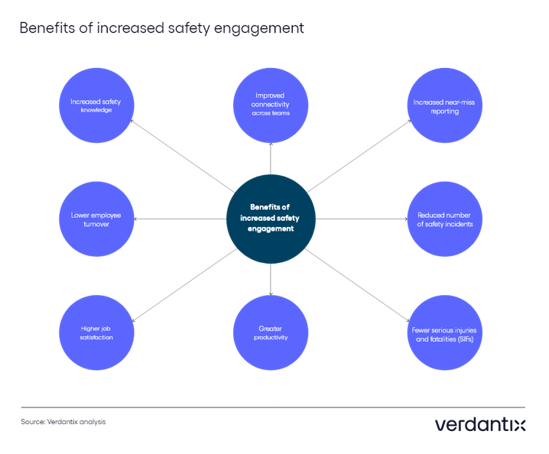
The Synergy Between Tech and People
Technology is a powerful tool for engagement. For example, AI-powered chatbots can answer employee safety questions 24/7, while virtual reality (VR) training simulations can create immersive and realistic learning experiences. However, true engagement goes beyond digital tools. It requires a cultural shift where safety is seen as a shared value, a responsibility everyone takes ownership of.
When cutting-edge technology is combined with a culture of employee engagement, the results are transformative.
Imagine a workplace where AI proactively identifies hazards, employees readily report safety concerns, and data-driven insights guide continuous improvement efforts. This is the future of EHS – a high-tech environment fueled by a workforce that is actively engaged in creating a safer, healthier, and more sustainable world.
Building a Digital EHS Roadmap
As firms strive to modernize EHS operations, a key challenge lies in overcoming outdated systems, according to Nathan Goldstein, Senior Analyst. He highlights, “Proactive management of solution ecosystems and robust digital roadmaps are crucial to preemptively mitigating problems, with 55% of EHS decision-makers surveyed by Verdantix looking to have a unified global software solution.”
Over the next two years, a successful EHS digitization strategy will likely focus on:
- System Consolidation: Migrating from legacy systems to integrated platforms that streamline data collection, analysis, and reporting.
- Cloud Adoption: Leveraging cloud-based solutions to ensure scalability, accessibility, and real-time data availability.
- Data Integration: Breaking down data silos and creating a unified information ecosystem for comprehensive risk management and informed decision-making.
- Change Management: Developing a clear communication and training plan to ensure employee buy-in and successful adoption of new technologies.
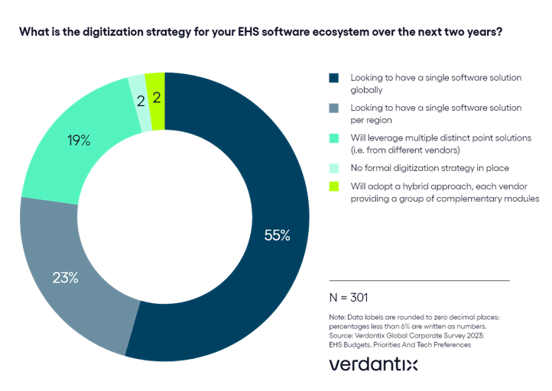
Aligning Budgets with Sustainability
The focus on environmental sustainability is shaping EHS service budgets. As April Choy, Analyst, explains, “As corporate sustainability takes centre stage, firms are prioritizing spending on carbon emissions and environmental impact. In a recent Verdantix survey, 64% of EHS leaders reported an increase in budget for sustainability management services, underscoring the pivotal role of service firm expertise in driving impactful initiatives.”
We can expect this trend to continue in the next 12 months. EHS budgets will likely see an increase in allocations for:
- Sustainability Consulting: Expertise in areas like carbon footprint reduction, circular economy practices, and environmental compliance will be in high demand.
- Data Management and Analytics: Services that help organizations collect, analyze, and interpret environmental data to inform strategic decision-making.
- ESG Reporting and Disclosure: Support in complying with evolving ESG reporting requirements and communicating sustainability performance to stakeholders.
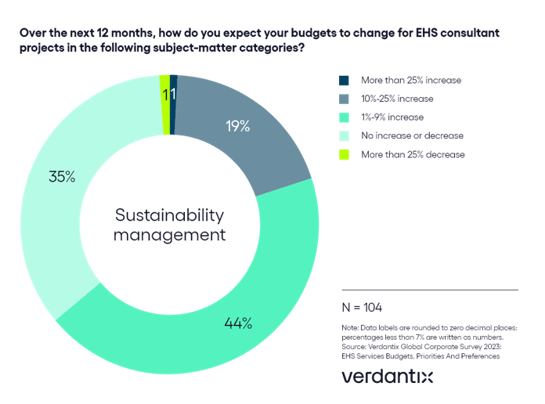
The Vital Role of Third-Party Services
In this evolving landscape, third-party EHS services play a crucial role in supporting EHS activities. As EHS professionals navigate increasingly multifaceted roles, Tom Brown, Senior Analyst, points out, “relying on third-party services becomes vital to address expertise gaps. Among the EHS leaders surveyed by Verdantix, 61% emphasize the ‘very important’ role of third-party services in supporting IH/OH obligations, underlining the ongoing reliance on external expertise for specialized tasks.”
Third-party service providers offer a wide range of benefits, including:
- Specialized Expertise: Access to consultants with deep knowledge in specific areas like industrial hygiene, occupational health, and environmental compliance.
- Scalability and Cost-Effectiveness: Supplementing internal teams during peak workloads or for specific projects, without the need for permanent hires.
- Staying Current with Regulations: Ensuring compliance with complex and ever-changing environmental and safety regulations.
- Technology Implementation and Support: Providing guidance and expertise in selecting, implementing, and maintaining EHS software solutions.
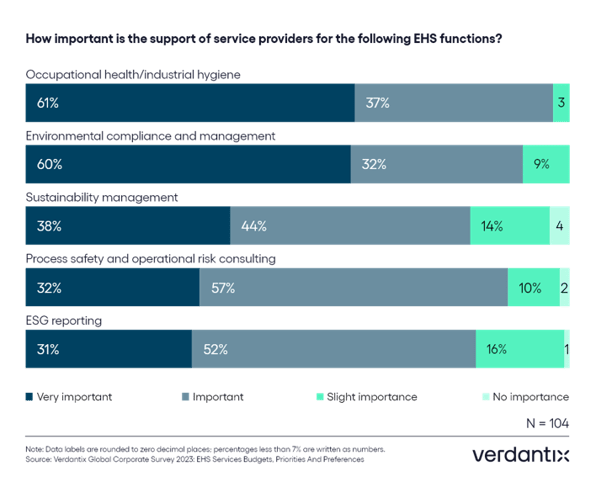
A Symbiotic Future
The future of EHS is innovative technology, a culture of employee engagement, and a growing focus on environmental responsibility.
By leveraging these advancements, organizations can create a work environment that is not only safe and healthy, but also sustainable and productive.
Here’s how this future might unfold:
- Tech-Empowered Workforce: EHS professionals will have access to a powerful suite of AI-powered tools, real-time data analytics, and interconnected IoT devices. This will enable them to automate tasks, predict hazards, and make data-driven decisions that enhance worker safety and environmental protection.
- Safety as a Shared Value: A cultural shift will see safety transformed from a compliance burden to a shared responsibility. Interactive training programs, gamification elements, and open communication channels will foster employee engagement and empower them to actively participate in safety initiatives.
- Sustainable Practices Take Center Stage: EHS strategies will become intrinsically linked to environmental sustainability goals. Businesses will prioritize carbon footprint reduction, implement circular economy practices, and strive for zero-waste operations. Third-party service providers with expertise in these areas will be in high demand.
This confluence of trends will usher in a new era of EHS excellence. It’s a future where technology empowers, employees are engaged, and environmental responsibility becomes a core value.
The result: a safer, healthier, and more sustainable world for all.

